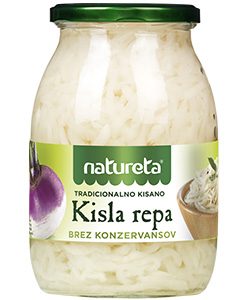 Sour turnips are a tangy and crisp alternative to sauerkraut–personally I think they are 100% better. Serve them like you would sauerkraut or relish, for example to accompany sausages or dress up a meat and cheese sandwich.
Sour turnips are a tangy and crisp alternative to sauerkraut–personally I think they are 100% better. Serve them like you would sauerkraut or relish, for example to accompany sausages or dress up a meat and cheese sandwich.
Sour turnips are made the same way as sauerkraut, by layering shredded vegetables with salt and allowing them to ferment. Here is a simple recipe.
How to Make Sour Turnips (kisla repa or sauer ruben)
Makes about 1 pint
Ingredients:
- 2 to 3 cups peeled and shredded turnips (about 1 pound or 3 medium)
- 1/3 cup (3.2 ounces) pickling salt (do not use table, sea, or iodized salt)
Directions:
- Use only young, tender, very fresh turnips. Wash, peel, and shred using a grater or mandoline slicer. Weigh or measure the shredded turnips to ensure you have the correct ratio of vegetables and salt.
- In a large bowl, toss together the turnips and pickling salt until evenly mixed. Pack firmly into a sterilized 1-quart, wide-mouth canning jar, pressing each layer to draw out juices. Leave 2 to 3 inches headspace. If juices do not cover turnips, prepare a very weak brine using 1½ tablespoons pickling salt per quart of boiling water. Cool and pour enough brine over tunips to cover completely.
- Fill a plastic bag with brine and place over the turnips to seal the jar completely. Place the jar on a tray to catch any spill over during fermentation. Store container at 64°F to 72°F and allow to ferment for 2 to 4 weeks. Do not disturb turnips until fermentation is complete. Fermentation is complete when the bubbling stops, turnips are transparent and taste slightly tangy. Mold, soft vegetables, or rotten odors indicate spoilage; discard these vegetables without tasting.
- Remove the brine-filled bag, cover the jar, and store sour turnips in the refrigerator. Keep the vegetables completely submerged in brine at all times during storage. Under ideal conditions, fermented vegetables may be stored in the refrigerator up to 6 months.
 Check the container once a week for a white scum floating on the surface of the brine or any signs of spoilage (soft vegetables or rotten odors). Remove scum immediately if it appears–it isn’t harmful but can create off-flavors if not removed.
Check the container once a week for a white scum floating on the surface of the brine or any signs of spoilage (soft vegetables or rotten odors). Remove scum immediately if it appears–it isn’t harmful but can create off-flavors if not removed.
For more food preservation methods, get the book The Home Preserving Bible by Carole Cancler, available from booksellers everywhere.




